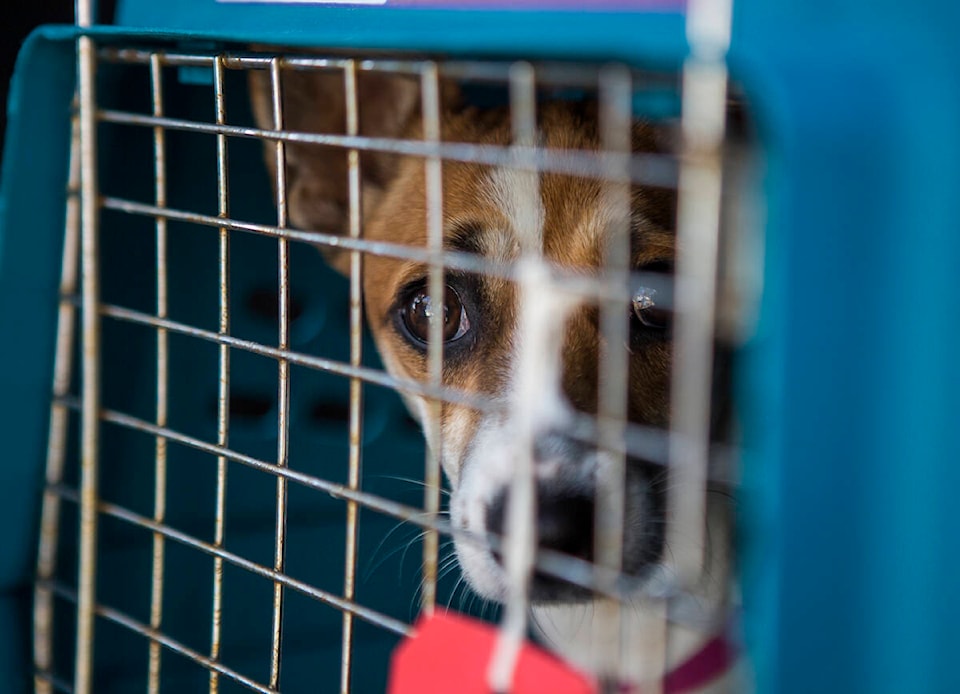For animals and their owners, separation anxiety can be a challenge – one that grew as humans returned to normal lives as pandemic restrictions lifted.
Luckily, there are ways to both prevent and help the problem.
Tell-tale signs that a dog is experiencing separation anxiety include panting, hiding, trembling, not wanting to eat or showing signs of anxiety when their owner gets ready to leave, the British Columbia Society for the Prevention of Cruelty to Animals (BC SPCA) said.
They may cause damage to the windows or the door their owner leaves from, or gain injuries such as bleeding paws, broken teeth and bleeding from the mouth. They may also refuse to eat when their owner is not home, even refusing high-value treats, but eat once the owner comes back.
Cats can also experience separation anxiety when routine changes cause them to be alone for more time than normal and may exhibit signs such as excessive vocalization, inappropriate defecation (outside the litter box), vomiting and destructive behaviours.
So, why do some pets develop separation anxiety and some don’t?
“Typically, it’s because dogs [pets] have never been exposed to gradual separation from their owners,” said Jeff Reid, owner and trainer at Rescue Me Canine Training in Victoria. “We see it a lot during Covid because people were working from home and tons of dogs spent 24/7 with their owners, especially puppies. Then all of a sudden people go back to work leaving the dog [pet] in a new situation; they’re unfamiliar with it and that makes them uncomfortable.”

To prevent problems from developing, pets should be exposed to separation over time and learn from a young age that separation is okay.
“Get them used to a gradual distance,” Reid said. “Try to encourage them to not follow you from room to room, have some times where you go out briefly and then come back. Try not to make a lot out of arrivals and departures. Everyone loves when they come home and their dog is happy to see them but if you coming home is the best part of the day, your leaving is the worst. So really, treat coming and going from the house the same that you treat coming and going from a room.” These same principles also apply to cats.
If a pet has developed anxiety, it is important to not punish them for their unintentional anxiety-related behaviours, The British Columbia Society for the Prevention of Cruelty to Animals (BC SPCA) said. Separation anxiety is highly treatable with a combination of medication and behaviour modification therapy with a trainer. And veterinarians can help determine whether a pet has separation anxiety or another condition.
“Often people think that problems like that can sit and it’ll eventually get better on its own. In most cases that isn’t what happens,” Reid said. “More importantly, you’ve wasted a lot of training time. We’re much better off trying to address these things when a dog is nine months old rather than when they’re four – it’s a more malleable dog. There’s also a lot of misinformation out there on how to address dog behaviour problems. It is really easy to get the wrong advice through YouTube videos or through a friend, so I think it’s important to get on training techniques right from the get-go.”
Crate training is seen by some as a solution, though it is a highly debated topic – crate advocates often claim dogs are den-dwelling animals, whereas in some countries like Sweden, regulations forbid keeping dogs in cages or other enclosures below a certain size (the size required for an enclosure to be exempt from such regulations starts at 22 sq ft.).
If one decides to crate train, experts recommend associating the crate only with positive experiences, introducing it slowly, and providing toys and treats. PETA warns that psychological and physical problems can result from being crated too long.
Reid notes that putting dogs in a physically confined space, such as a crate or locking them in a bedroom may be seen as a solution to physically control the animal, but it’s a band-aid solution that lacks cooperation from the dog and doesn’t solve the underlying anxiety.
“We need to teach the dog to accept and allow space and distance from the owner, rather than force it on them,” Reid said.
Dr Diane van Rooy, from the Faculty of Veterinary and Agriculture Sciences at the University of Melbourne, said exercise can also help. She recommends taking your dog for a walk in the morning and then settling down for half an hour or so before you leave.
Ultimately, the success and treatment time for separation anxiety through training depends on how committed the dog is to the behaviour, the personality of the dog, the severity of the anxiety and how dedicated the owner is to training, Reid said.
But if your pet is experiencing separation anxiety, fear not: in most cases, the condition is completely resolvable said Reid. With a little patience, your pet can gain a healthy sense of independence back and live a purrfectly and pawsitively happy life.
READ MORE: Victoria veteran begs people to please not touch his service dog



